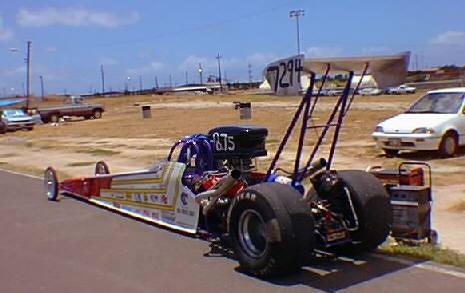 It is for this reason, that the use of nitrous oxide is primarily confined to drag racing, street racing, and other short duration racing applications. Maximum acceleration is the primary objective for these sports, while endurance is not.
It is for this reason, that the use of nitrous oxide is primarily confined to drag racing, street racing, and other short duration racing applications. Maximum acceleration is the primary objective for these sports, while endurance is not. Erratum: After reading the web page on N2O in Sept 2004, Marshall Hiepler of Sauer Compressors, USA, sent me the following extra information about the use of nitrous oxide to boost car performance:
I was looking at your web page concerning nitrous oxide, and read about its use for improving the performance of race cars. I am a race enthusiast, and would like to offer some additional details pertaining to the use of the gas in racing applications, in an effort to improve your web page further. (Which is rather difficult to do.)
Firstly, the photo that is shown, next to the paragraph in question, is not the type of racing that would particularly benefit from the use of nitrous oxide. Although it does provide impressive power gains for naturally aspirated engines, the rate of depletion of a 10 - 20 lb bottle of nitrous oxide is rapid. Depending on the displacement of the engine, only 2 - 5 minutes of boost could be realized.
 It is for this reason, that the use of nitrous oxide is primarily confined to drag racing, street racing, and other short duration racing applications. Maximum acceleration is the primary objective for these sports, while endurance is not.
It is for this reason, that the use of nitrous oxide is primarily confined to drag racing, street racing, and other short duration racing applications. Maximum acceleration is the primary objective for these sports, while endurance is not.
These engines are designed with large intake and exhaust valves, and gas flow passages for maximum rpm - which is where the power plant will spend the majority of its time; however briefly. The Nitrous bottle is plumbed to an electric solenoid valve which permits nitrous oxide to flow in a liquid state into the engine's air intake manifold via precise orifices to control flow. These orifices are engineered to deliver a measured supply of the liquid nitrous oxide, which has been calculated to be appropriate for wide open throttle only. The nitrous oxide changes state immediately upon injection into the intake manifold, thus affording the advantages of its latent heat factor, as you described. These advantages are numerous, as you also mentioned, the most notable being the change in charge density. The overall density of the fuel/air mixture being drawn into the combustion chamber increases sharply as the nitrous oxide changes from liquid to a gas within the intake passage. Most engine builders will incorporate an additional means of simultaneously enrichening the fuel to air ratio, so as to take full advantage of the extra oxygen that is released by the nitrous oxide during combustion. Furthermore, the reduced temperature of the intake charge allows for an increased compression ratio that would otherwise not be possible, due to the pre-detonation of the charge during the compression stroke. Pre-detonation must be avoided at all cost, as it is extremely damaging to most race engines.
In addition to the advantages gained with the use of higher compression ratios, an effective alternative is to pressurize the intake charge. This is often done with a turbo-charger which takes advantage of the expansion of the exhaust gases as they exit the combustion chamber. Although heating of the intake charge is a negative drawback commonly associated with the turbo-charging of engines, this factor is effectively negated when used in conjunction with nitrous oxide injection.
P.S: A friend of mine experimented with the use of Nitrous Oxide (laughing gas) during his teenage years. At the time, he felt certain it was safe to use, while noting with confidence that it is widely used in dentistry, and is generally regarded as harmless. However, as his experimentation increased, along with a corresponding increase in consumption of the gas, he began to experience a disturbing side affect which impaired the clarity of his vision while under the effect of the gas, and to a lesser degree when the gas had worn off. The discovery of this unwanted side effect prompted him to discontinue the use of nitrous oxide in a recreational sense, after which, he was relieved to find that the residual impairment of his vision subsided within a short period of time. I thought I might mention my friend's experience, in case you might choose to reference it on your web page in an effort to educate those who might similarly be inclined to regard the gas as being harmless in all regards.